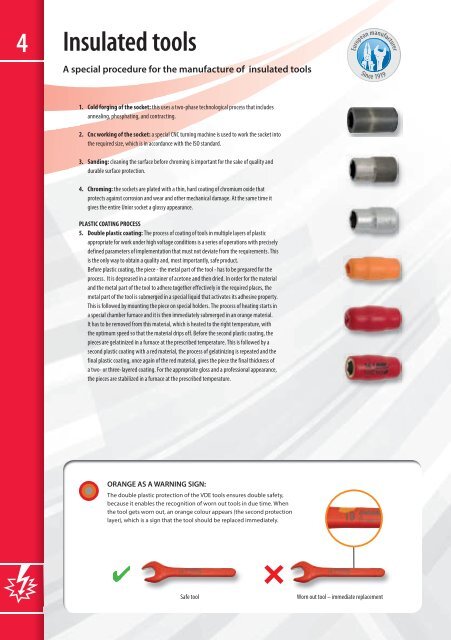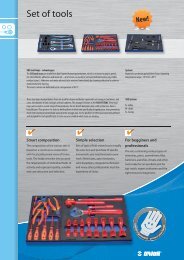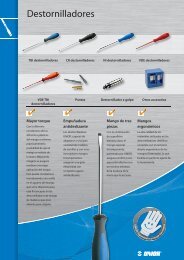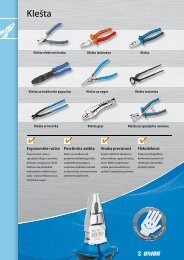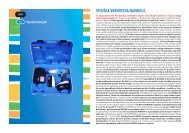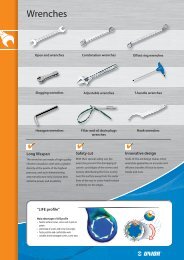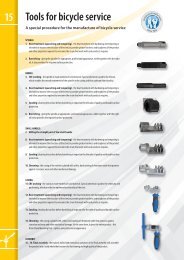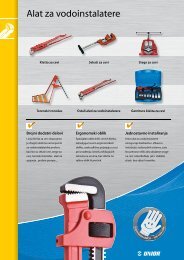- Page 1 and 2:
EN Catalogue 2013 - 2014 www.uniort
- Page 3 and 4:
1 2 3 4 5 6 7 8 9 10 11 12 13 14 15
- Page 5 and 6:
pany has been an ally to both amate
- Page 7 and 8:
In the mid-1970s Unior began buildi
- Page 9 and 10:
3. Flexible Production Processes Th
- Page 11 and 12:
8. Ergonomic shape can be implement
- Page 13 and 14:
Unior has implemented and certified
- Page 15 and 16:
Effective for Points of Sale Unior
- Page 17 and 18:
Save Space The well thought out pac
- Page 19 and 20:
Special designed boxes The function
- Page 21 and 22:
Legend of symbols used in catalogue
- Page 23 and 24:
Long lifespan The wrenches are made
- Page 25 and 26:
110/1CS Set of open end wrenches in
- Page 27 and 28:
110/2CS Set of open end wrenches in
- Page 29 and 30:
112/2 Open end wrench • material:
- Page 31 and 32:
L B2 B1 A2 A1 618501 7/8" 303 34.1
- Page 33 and 34:
120/2CB Set of combination wrenches
- Page 35 and 36:
619505 125/1CT 3/8" - 7/8" / 9 1107
- Page 37 and 38:
L B2 B1 A2 A1 611767 14 206 22 31.5
- Page 39 and 40:
180/1CS Set of offset ring wrenches
- Page 41 and 42:
183/2CB Set of offset open ring wre
- Page 43 and 44:
170/2 Forged ratchet ring wrench
- Page 45 and 46:
255/2 Hook wrench • material: chr
- Page 47 and 48:
194/1B2 1/2" drive swivel with T -
- Page 49 and 50:
176CS6 Set of double ended offset s
- Page 51 and 52:
215/2CB Set of tubular box wrenches
- Page 53 and 54:
193HXCS Set of hexagonal head screw
- Page 55 and 56:
220/3 Hexagon wrench • material:
- Page 57 and 58:
L1 L2 608511 2 102 18 7 608512 2.5
- Page 59 and 60:
220/7TX Wrench with TX profile and
- Page 61 and 62:
221AHXPB3 Set of hexagon wrenches w
- Page 63 and 64:
205/2 Strap wrench • material: ch
- Page 65 and 66:
Simple use The operation of the rat
- Page 67 and 68:
188/2L6p Socket 1/4", long type •
- Page 69 and 70:
188.3/2 Sliding T - handle 1/4" •
- Page 71 and 72:
188BI12P16 Socket set 1/4" in metal
- Page 73 and 74:
238/1 6p Socket 3/8" • material:
- Page 75 and 76:
236/2HX Hexagonal screwdriver socke
- Page 77 and 78:
238.1/1FBI Flexible reversible ratc
- Page 79 and 80:
239A12P24 Socket set 3/8" in metal
- Page 81 and 82: D1 D2 L T 609373 3/4" 26.8 24 38 14
- Page 83 and 84: 192/2R Screwdriver socket 1/2" with
- Page 85 and 86: 192/14INCH Hexagonal screwdriver so
- Page 87 and 88: 190.3/1 Sliding T - handle 1/2" •
- Page 89 and 90: 190H1 10 pieces set of socket clips
- Page 91 and 92: 190BI6P43 Socket set 1/2" and 1/4"
- Page 93 and 94: D1 D2 L T 610803 30 42 40 90 28 503
- Page 95 and 96: 197MB4 Socket set 3/4" in metal box
- Page 97 and 98: D2 D1 L T 612068 16 22 24 30 12 65
- Page 99 and 100: D1 D2 L T 619147 12 20 24.8 80 14 1
- Page 101 and 102: 231/4ATX Impact screwdriver socket
- Page 103 and 104: 232.4/4 Impact extension bar 3/4"
- Page 105 and 106: 233.8/4 Impact accessories 1" • m
- Page 107 and 108: Ergonomic handles With ergonomic ha
- Page 109 and 110: 405/4P Combination pliers material:
- Page 111 and 112: 466/4G Heavy duty diagonal cutting
- Page 113 and 114: 508/4P Long nose pliers with side c
- Page 115 and 116: 447/1BIHPPST Set of waterpump plier
- Page 117 and 118: 445/1BI Double groove joint pliers
- Page 119 and 120: 503/4P Telephone pliers material: s
- Page 121 and 122: 428/4 Crimp lever pliers jaws drop
- Page 123 and 124: 423.6B Male spade terminals (20 pcs
- Page 125 and 126: 534PLUS/1DP External lock rings pli
- Page 127 and 128: L B A C 608725 225 54 25 24 419 608
- Page 129 and 130: 434/3D Wheel and rack grip pliers j
- Page 131: 515/1BI Revolving punch pliers mate
- Page 135 and 136: Features of Unior’s screwdrivers
- Page 137 and 138: 180/2VDEDPCB Set of insulated singl
- Page 139 and 140: 239VDEDP6P10 Insulated socket set 3
- Page 141 and 142: 190VDEDP6P13B Insulated socket set
- Page 143 and 144: 420/1VDEDP Linemen`s pliers materia
- Page 145 and 146: 466/1VDE Heavy duty diagonal cuttin
- Page 147 and 148: 506/1VDE Long nose pliers with side
- Page 149 and 150: 512/1VDEDP Long nose pliers with si
- Page 151 and 152: 623VDETBI Double-crosstip (PZ) scre
- Page 153 and 154: 1351VDE Plastic clamp plastic mater
- Page 155 and 156: 905VDEBI Tool set VDE BI in bag 617
- Page 157 and 158: 964VDE8A Set of insulated flat scre
- Page 159 and 160: Numerous additional parts The range
- Page 161 and 162: 442/1BIST Set of variable joint HYP
- Page 163 and 164: 449/1PYTHON Waterpump box joint pli
- Page 165 and 166: 483/6A Grip pipe wrench with smooth
- Page 167 and 168: 486/6 Pipe roughing wrench • mate
- Page 169 and 170: 355/6 Tube flaring tools • housin
- Page 171 and 172: 484/6 Chain pipe wrenches • mater
- Page 173 and 174: Secure cut Designed for a secure an
- Page 175 and 176: 563R-PLUS/7DP Universal tin snips m
- Page 177 and 178: 566R/7P Shape tin snips • materia
- Page 179 and 180: 583/6 PVC pipe cutter • material:
- Page 181 and 182: 586/6 Threaded rod cutter • made
- Page 183 and 184:
596/6A Bolt cutter • material: cu
- Page 185 and 186:
542.1/5 Spare spring for 542/4PR 60
- Page 187 and 188:
Ergonomically designed handles The
- Page 189 and 190:
605CR Flat screwdriver CR • blade
- Page 191 and 192:
626CR Stubby crosstip (PH) screwdri
- Page 193 and 194:
621CR Screwdriver CR with TX profil
- Page 195 and 196:
607PB9TBI Set of screwdrivers TBI i
- Page 197 and 198:
635Bits Reversible blade for bits f
- Page 199 and 200:
6472C6,3 TX profile bit, 3 pcs set
- Page 201 and 202:
6715E6,3 Bits adaptor E6, 3 (1/4")
- Page 203 and 204:
17. Heat treatment (quenching and t
- Page 205 and 206:
681/5 Puller with two sliding arms
- Page 207 and 208:
687/5 Puller with five adjustable a
- Page 209 and 210:
2051/4 Suspension compressor for sh
- Page 211 and 212:
2210/2 Timing pulley puller • mat
- Page 213 and 214:
Ergonomic design Their most common
- Page 215 and 216:
810 Masons` hammer with wooden hand
- Page 217 and 218:
819A Bumping hammer • non rebound
- Page 219 and 220:
641/6 Pin punch • material: chrom
- Page 221 and 222:
642LPB Set of letter steel punches
- Page 223 and 224:
667/6AHS Jointing chisel with guard
- Page 225 and 226:
Quality sheet steel Tool carriages,
- Page 227 and 228:
920PLUS1 Tool carriage Europlus •
- Page 229 and 230:
940EV6 Tool carriage Eurovision •
- Page 231 and 232:
940E6 Tool carriage Eurostyle • l
- Page 233 and 234:
940H3 Tool carriage Hercules • lo
- Page 235 and 236:
610174 R4 490x66x90 Handle 940H1, H
- Page 237 and 238:
946AC Work bench with cabinet • c
- Page 239 and 240:
943P8 Support for modular work benc
- Page 241 and 242:
942A11 Modular work bench 619040 94
- Page 243 and 244:
944A4 Modular work bench 619057 944
- Page 245 and 246:
944A22 Modular work bench 619075 94
- Page 247 and 248:
938/3V Tool chest Eurostyle - 3 com
- Page 249 and 250:
915/5 Tool box - 5 compartments •
- Page 251 and 252:
948E1.1 Accessories for 948E1 • a
- Page 253 and 254:
950/3V Wardrobe cabinet, 3 compartm
- Page 255 and 256:
975 Metal stand for catalogue • m
- Page 257 and 258:
980P2 Metal stand for two arms pull
- Page 259 and 260:
1100 Large tool case for maintenanc
- Page 261 and 262:
995DNL, 995DN1, 995DN1L Merchandise
- Page 263 and 264:
995MD Modular holder for merchandis
- Page 265 and 266:
995MD Modular holder for merchandis
- Page 267 and 268:
998B Mobile merchandiser with full
- Page 269 and 270:
1535 Pneumatic ratchet and socket s
- Page 271 and 272:
1/4” 617793 Art. 1506 KZ7 3/8”
- Page 273 and 274:
1562 Pneumatic reversible hammer 1/
- Page 275 and 276:
1514 Stroke pneumatic hammer used f
- Page 277 and 278:
1510 Pneumatic sander free speed 10
- Page 279 and 280:
1517S Pneumatic angle sander free s
- Page 281 and 282:
1500 Pneumatic filter regulator and
- Page 283 and 284:
1507Z10 Coupling, male part outside
- Page 285 and 286:
262 Dial torque wrench 1/2" double
- Page 287 and 288:
264 Slipper torque wrench reversibl
- Page 289 and 290:
272 External micrometer made of qua
- Page 291 and 292:
1252 Alu - spirit level with magnet
- Page 293 and 294:
1270 Mason's staffs special alumini
- Page 295 and 296:
P7 472/4E Electronic flat nose plie
- Page 297 and 298:
403B Set of electronic pliers in ca
- Page 299 and 300:
2077/2BI Spring clip pliers materia
- Page 301 and 302:
2081/3 Grip hose clamp pliers for s
- Page 303 and 304:
2087 Flexible pick up tool with mag
- Page 305 and 306:
1977/6 Oil-filter wrench used with
- Page 307 and 308:
206/2 Chain wrench material: chrome
- Page 309 and 310:
1921 Thin doe dolly material: speci
- Page 311 and 312:
1940/2BI Trim pin remover material:
- Page 313 and 314:
1943.1SQ Square steel wire for wind
- Page 315 and 316:
2027/2 Hub and wheel drum puller ma
- Page 317 and 318:
2033/2PB Disc spreader in plastic b
- Page 319 and 320:
2041/2 Homokinetic joint puller The
- Page 321 and 322:
2052/4 Compressor for shock absorbe
- Page 323 and 324:
2177.04 Cable release tool P8 for r
- Page 325 and 326:
2177.18 Cable release tool with asi
- Page 327 and 328:
2177.35 Cable release tool with sim
- Page 329 and 330:
194/2D1L T - handle spark plug wren
- Page 331 and 332:
2206 Universal clutch aligner desig
- Page 333 and 334:
2209 Alternator combination socket
- Page 335 and 336:
2301SOS6 Set of automotive tools in
- Page 337 and 338:
New advanced technology The use of
- Page 339 and 340:
1681.1/4 Head set cup remover • m
- Page 341 and 342:
1701/5 Bushing extractor set Tool i
- Page 343 and 344:
1678/2BI Tools for bike frame mater
- Page 345 and 346:
1695.1AR Pedal taps material: speci
- Page 347 and 348:
1661/4 Crank puller The crank pulle
- Page 349 and 350:
1671.7/2BI Truvativ® cartridge bot
- Page 351 and 352:
1625/2 Tool for removing bottom bra
- Page 353 and 354:
1670/2BI Freewheel remover The free
- Page 355 and 356:
1640/1DP Chain rivet pliers materia
- Page 357 and 358:
584/2POLLY Steel wire cutter materi
- Page 359 and 360:
1632 Flat spoke wrench • material
- Page 361 and 362:
1612/2A Hub cone wrench Made of qua
- Page 363 and 364:
1693.1 Jaw with spring for 1693 Sui
- Page 365 and 366:
1689 Wheel centering stand, for pro
- Page 367 and 368:
1600BT Empty bag for 1600B A B 6172
- Page 369 and 370:
1600SOS9 Bike tool set in SOS tool
- Page 371 and 372:
Vices Clamps Saws Files Rasps Scrap
- Page 373 and 374:
721.1/6 Swivel base for 721/6 and 7
- Page 375 and 376:
705/5AMH Heavy duty engineering U c
- Page 377 and 378:
760H1/2S Flat file with handle, hal
- Page 379 and 380:
764H1/2S Three-square file with han
- Page 381 and 382:
778/4 Screw extractor for unscrewin
- Page 383 and 384:
1210 Flat cutting-off wheels, for s
- Page 385 and 386:
1301.1/4 Nosepiece for blind-rivet
- Page 387 and 388:
AS49 Universal sprayer loosens rust
- Page 389 and 390:
Smart composition The composition o
- Page 391 and 392:
964/2ASSOS Set of combinations wren
- Page 393 and 394:
964/7SOS Set of BI and grip pliers
- Page 395 and 396:
964/13ASOS Set of hexagonal screwdr
- Page 397 and 398:
964/25SOS Set of sockets 3/8" in SO
- Page 399 and 400:
964/32SOS Set of BI pliers and hamm
- Page 401 and 402:
964ECO9 Set of TBI screwdrivers in
- Page 403 and 404:
220/3 (3, 4, 5, 6, 8, 10, 12, 14, 1
- Page 405 and 406:
1000G Tool set 631 (6 - 12) 640/6 (
- Page 407 and 408:
190.3/1 (1/2") 190.1/1ABI (1/2") 19
- Page 409 and 410:
1001F6 556B (160) 572R/7PR (280) 60
- Page 411 and 412:
911N12P21 Socket set 1/2" in SOS to
- Page 413 and 414:
1805 Safety shoes, normal antistati
- Page 415 and 416:
1840 Cap Unior 621691 80 1850M T-sh
- Page 417 and 418:
45/2 Bottle opener L B A 603886 13
- Page 419 and 420:
KAT.OPR Catalogue workshop equipmen
- Page 421 and 422:
1843OTR.KRO Label baby in car, Unig
- Page 423 and 424:
1872.721 Rollwall 721/6 622566 1m x
- Page 425 and 426:
PIC.IM5 Picture with wrenches 62261
- Page 427 and 428:
Size Min. torque ISO 4762 ISO 4026
- Page 429 and 430:
Conversion of geometric units measu
- Page 431 and 432:
600812 213/6 62 600812 213/6 319 60
- Page 433 and 434:
604692 6463TINC6,3 198 604693 6463T
- Page 435 and 436:
608316 621E 296 608354 406/1BI 109
- Page 437 and 438:
610809 197/1L6p 93 610810 197/1L6p
- Page 439 and 440:
612890 433/4D 130 612891 433/4E 130
- Page 441 and 442:
616729 441/4BI 162 616730 441/4G 11
- Page 443 and 444:
618498 120/1 30 618499 120/1 30 618
- Page 445 and 446:
619230 1932 310 619231 1933 310 619
- Page 447 and 448:
620805 188/2F12p 66 620806 188/2F12
- Page 449 and 450:
622597 940ES3A 229 622597 940ES3A 2
- Page 451 and 452:
Cable release tool with pin head 21
- Page 453 and 454:
Half-round file with handle, smooth
- Page 455 and 456:
Oil can with flexible spout 1375/6
- Page 457 and 458:
Set of cone wrenches 1612PB 360 Set
- Page 459 and 460:
Socket set 1/2" in metal box 190BI6
- Page 461 and 462:
Tool set CR in bag 905CR 410 Tool s
- Page 463 and 464:
190BI6P22IN Socket set 1/2" in meta
- Page 465 and 466:
423.3R Spade terminals (20 pcs) 122
- Page 467 and 468:
639D Awl with round, double bent sm
- Page 469 and 470:
964/9DSOS Set of screwdrivers TBI i
- Page 471 and 472:
1668/2 Wrench for front sprocket nu
- Page 473 and 474:
PLA.GIRL3 Poster with girl on carri
- Page 475 and 476:
Guarantee UNIOR guarantees for all


